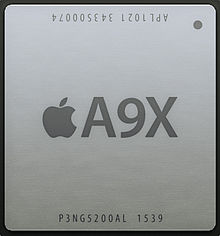Apple A9X
 Apple A9X chip | |
| General information | |
|---|---|
| Launched | September 9, 2015 |
| Discontinued | June 5, 2017 |
| Designed by | Apple Inc. |
| Common manufacturer(s) | |
| Product code | APL1021 |
| Performance | |
| Max. CPU clock rate | 2.16 GHz[1] to 2.26 GHz[2] |
| Cache | |
| L1 cache | Per core: 64 KB instruction + 64 KB data |
| L2 cache | 3 MB shared |
| Architecture and classification | |
| Application | Mobile |
| Technology node | 16 nm (TSMC)[3] |
| Microarchitecture | Twister[4][5] ARMv8-A-compatible |
| Instruction set | A64, A32, T32 |
| Physical specifications | |
| Cores |
|
| GPU(s) | PowerVR Series 7XT (12 cores)[3] |
| Products, models, variants | |
| Variant(s) | |
| History | |
| Predecessor(s) | Apple A8X |
| Successor(s) | Apple A10X |
The Apple A9X is a 64-bit ARM based system on a chip (SoC) designed by Apple Inc. It first appeared in the iPad Pro, which was announced on September 9, 2015 and was released on November 11, 2015.[6] The A9X has the M9 motion coprocessor embedded in it, a new innovation not seen in previous chip generations. It is a variant of the A9 and Apple claims that it has 1.8 times the CPU performance and 2 times the GPU performance of its predecessor, the A8X.[7]
Design
The A9X features an Apple-designed 64-bit ARMv8-A dual-core CPU called "Twister".[5] It offers double the memory bandwidth and double the storage performance of the Apple A8X.[8]
Unlike the A9, the A9X does not contain an L3 cache due to its significant DRAM bandwidth. The A9X is paired with 4 GB of LPDDR4 memory in the 12.9" iPad Pro and 2 GB of LPDDR4 memory in the 9.7" iPad Pro with a total bandwidth of 51.2 GB/s. This high bandwidth is necessary to feed the SoC's 12-core PowerVR 7 Series GPU.[9] The RAM is not included in the A9X package unlike its sibling, the A9.
The A9X uses the same NAND interface as the A9, which uses an Apple-designed NVMe-based controller that communicates over a PCIe connection.[10] The iPad Pro's NAND design is more akin to a PC-class SSD than embedded flash memory common on mobile devices. This gives the iPad Pro a significant storage performance advantage over competitors which often use mSATA or eMMC to connect to their storage systems.
Products that include the Apple A9X
See also
- Apple mobile application processors, the range of ARM-based mobile processors designed by Apple for their consumer electronic devices.
- Apple Motion Coprocessors
- Comparison of ARMv8-A cores
References
- ^ 9.7 inch iPad Pro includes 2 GB RAM, slightly slower CPU than 12.9 inch iPad Pro
- ^ a b "The A9X SoC & More To Come - The iPad Pro Preview: Taking Notes With iPad Pro". AnandTech. November 11, 2015. Retrieved November 11, 2015.
- ^ a b Smith, Ryan (November 30, 2015). "More on Apple's A9X SoC". AnandTech. Retrieved November 30, 2015.
- ^ Joshua Ho. "iPhone 6s and iPhone 6s Plus Preliminary Results". anandtech.com.
- ^ a b Joshua Ho, Ryan Smith. "A9's CPU: Twister - The Apple iPhone 6s and iPhone 6s Plus Review". anandtech.com.
- ^ "Apple Introduces iPad Pro Featuring Epic 12.9-inch Retina Display" (Press release). Apple. September 9, 2015. Retrieved September 9, 2015.
- ^ Chester, Brandon (September 9, 2015). "Apple Announces the iPad Pro and iPad Mini 4". AnandTech. Retrieved September 9, 2015.
- ^ "Apple's new iPad Pro is an expansive 12.9 inches, available in November". Ars Technica. Retrieved 9 September 2015.
- ^ "More on Apple's A9X SoC: 147mm2@TSMC, 12 GPU Cores, No L3 Cache". AnandTech. Retrieved 30 November 2015.
- ^ "The Apple iPad Pro Review". Retrieved 25 January 2016.
